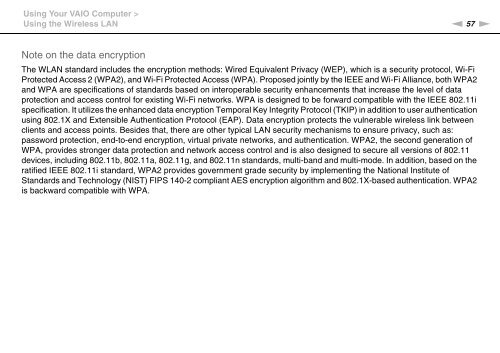Sony VPCEF3E1E - VPCEF3E1E Mode d'emploi Anglais
Sony VPCEF3E1E - VPCEF3E1E Mode d'emploi Anglais
Sony VPCEF3E1E - VPCEF3E1E Mode d'emploi Anglais
You also want an ePaper? Increase the reach of your titles
YUMPU automatically turns print PDFs into web optimized ePapers that Google loves.
Using Your VAIO Computer ><br />
Using the Wireless LAN<br />
n 57<br />
N<br />
Note on the data encryption<br />
The WLAN standard includes the encryption methods: Wired Equivalent Privacy (WEP), which is a security protocol, Wi-Fi<br />
Protected Access 2 (WPA2), and Wi-Fi Protected Access (WPA). Proposed jointly by the IEEE and Wi-Fi Alliance, both WPA2<br />
and WPA are specifications of standards based on interoperable security enhancements that increase the level of data<br />
protection and access control for existing Wi-Fi networks. WPA is designed to be forward compatible with the IEEE 802.11i<br />
specification. It utilizes the enhanced data encryption Temporal Key Integrity Protocol (TKIP) in addition to user authentication<br />
using 802.1X and Extensible Authentication Protocol (EAP). Data encryption protects the vulnerable wireless link between<br />
clients and access points. Besides that, there are other typical LAN security mechanisms to ensure privacy, such as:<br />
password protection, end-to-end encryption, virtual private networks, and authentication. WPA2, the second generation of<br />
WPA, provides stronger data protection and network access control and is also designed to secure all versions of 802.11<br />
devices, including 802.11b, 802.11a, 802.11g, and 802.11n standards, multi-band and multi-mode. In addition, based on the<br />
ratified IEEE 802.11i standard, WPA2 provides government grade security by implementing the National Institute of<br />
Standards and Technology (NIST) FIPS 140-2 compliant AES encryption algorithm and 802.1X-based authentication. WPA2<br />
is backward compatible with WPA.
















